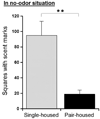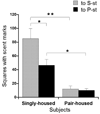Social features of scent-donor mice modulate scent marking of C57BL/6J recipient males
- PMID: 19616031
- PMCID: PMC2753713
- DOI: 10.1016/j.bbr.2009.07.007
Social features of scent-donor mice modulate scent marking of C57BL/6J recipient males
Abstract
Territorial male mice can form familiarity-dependent amicable relationships, suggesting that they manage their territorial aggressiveness based on individual recognition, which may be mediated by olfactory signals. The present study demonstrated modulatory effect of odorant cues from mice of different social/housing groups on territorial scent marking by C57BL/6J males. Pair-housed males deposited few scent marks in a novel situation without mouse odors, while singly-housed males marked more in the same situation (Experiment 1). However, when confronted by a conspecific, singly-housed males made fewer marks to pair-housed than to singly-housed stimulus males, while pair-housed males showed few marks to either stimulus animal (Experiment 2). Reduction in scent marking in singly-housed males was also seen on exposure to urine scent alone from a pair-housed male, indicating that the inhibitory cue is mediated by urinary odor (Experiment 3). This inhibitory odor was effective even when singly-housed males were placed in a no-odor environment following exposure to soiled bedding used by pair-housed males (Experiment 4). When singly-housed males were exposed to scent from subordinate males, they showed less marking than when the stimulus scent was from dominants or singly-housed males (Experiment 5). Scent marking was not influenced by the total amount of urine scent marks deposited on the substrates (Experiment 6), suggesting that it is a particular component in urinary odor rather than the magnitude of the odor, that plays a significant role in recipient behavior. Together, these experiments indicate that conspecific male odor signals modulate territorial scent marking behavior in mice.
Figures






References
-
- Aldhous P. The effects of individual cross-fostering on the development of intrasexual kin discrimination in male laboratory mice, Mus musculus L. Anim Behav. 1989;37:741–750.
-
- Arakawa H. Changes in the pattern of exploratory behavior are associated with the emergence of social dominance relationships in male rats. Dev Psychobiol. 2006;48:39–47. - PubMed
-
- Arakawa H. Ontogenetic interaction between social relationships and defensive burying behavior in the rat. Physiol Behav. 2007;90:751–759. - PubMed
Publication types
MeSH terms
Grants and funding
LinkOut - more resources
Full Text Sources

